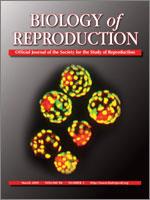Mouse spermatogenic cells are known to contain at least two isoforms of cytoplasmic poly(A)-binding proteins, PABPC1 and PABPC2 (previously known as PABPT). In this study, we have characterized PABPC1 and PABPC2. PABPC2 was present in pachytene spermatocytes and round spermatids, whereas elongating spermatids still included PABPC1. These two proteins are capable of binding mRNA poly(A) tails nonspecifically and of directly associating with each other and with several translational regulators, including EIF4G1, PAIP1, PAIP2, and PIWIL1 (previously known as MIWI). Moreover, both PABPC1 and PABPC2 exhibited the ability to enhance translation of a reporter mRNA in vitro. Despite these similarities, PABPC2 was distinguished from PABPC1 by the absence of PABPC2 in actively translating polyribosomes of testicular cells. PABPC1 was distributed in polyribosomes and in translationally inactive messenger ribonucleoprotein particles. Most importantly, PABPC2 and PIWIL1 were noticeably enriched in the chromatoid body of round spermatids. These results suggest that PABPC2 may function in translational repression during spermatogenesis.
How to translate text using browser tools
1 March 2009
Characterization of Two Cytoplasmic Poly(A)-Binding Proteins, PABPC1 and PABPC2, in Mouse Spermatogenic Cells
Masanori Kimura,
Kazuyuki Ishida,
Shin-ichi Kashiwabara,
Tadashi Baba
ACCESS THE FULL ARTICLE

Biology of Reproduction
Vol. 80 • No. 3
March 2009
Vol. 80 • No. 3
March 2009
Mouse
mRNA, poly(A)
PABP
poly(A)-binding protein
spermatogenesis
testis
translation




